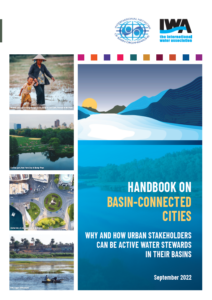IWA is pleased to share its latest publication: Handbook on Basin Connected Cities: Why and How Urban Stakeholders can be Active Water Stewards in their Basins, co-published with INBO.
Many of the global challenges such as urbanisation, climate change, increased resource demand and competition between different water users, impact the cities where most of us live. These create water risks for cities including flooding, water scarcity and pollution. Flooding can cause loss of life, homes and infrastructure, and negatively affect economic activities within cities. Floods also disrupt and limit access to resources that cities rely on, not only water, but also food and energy. Water scarcity and drought often lead to costly investment in capital intensive approaches to secure supply, and potentially use of unsafe alternative sources. Declining water quality can affect water supply and sustainability. According to a 2019 World Bank report, when rivers become very heavily polluted, regions downstream see reductions in economic growth, losing between 0.8 and 2.0 percent of economic growth. Poor water quality affects human health leading to a decline in livelihood and social well-being. Furthermore, reduced access to safe water can impact hygiene making it challenging to control water- and vector-borne diseases
These pressures and challenges highlight the need for more sustainable urban planning and public services. At the same time, linkages between urban and rural areas can be strengthened by building on their existing economic, social and environmental ties. By proactively taking part in basin management, the city secures water, food and energy resources, protects water quality, and increases resilience to extreme events. It is an opportune time to encourage collaborative action to improve connectivity between urban and wider basin stakeholders to optimise costs, resilience, and biodiversity. Implementing appropriate and sustainable solutions in line with governance in cities and their basins means working towards public policy coherence and efficient water management across administrative boundaries and sectors. This includes stakeholder engagement across catchments involving institutional actors, representatives of the civil sphere and citizens.
ABOUT THE HANDBOOK ON BASIN-CONNECTED CITIES
The IWA-INBO Handbook on Basin-Connected Cities aims to support decision making in strengthening the city’s connection and integration with its river basin. It expands on the IWA Action Agenda for Basin-Connected Cities, which provides a framework to influence and activate utilities, cities and their industries to become water stewards working with basin stakeholders.
The Action Agenda and Handbook have 3 main parts:
- Drivers for Action outlining how basin-wide risks are impacting urban areas from economic, environmental and social perspectives;
- Pathways for Action demonstrating how cities and their basins can actively cooperate; and
- Foundations for Action which are the elements needed to create an enabling environment to implement the pathways.
The Action Agenda for Basin-Connected Cities builds on IWA’s Principles for Water-Wise Cities, which aim to integrate water in planning across scales. The Principles support city leaders planning a future-proof access to safe water and sanitation for everyone in their cities, while delivering enhanced liveability for people and nature.
The Handbook is a comprehensive and detailed resource for practitioners, structured for quick reference. The purpose is to inform, influence and encourage urban stakeholders to take an active role in protecting and investing in water resources, together with basin and catchment organisations.
Download the handbook to learn more and join the conversation online using #BasinConnectedCities


